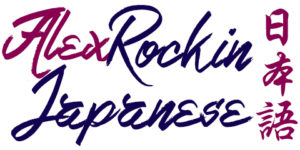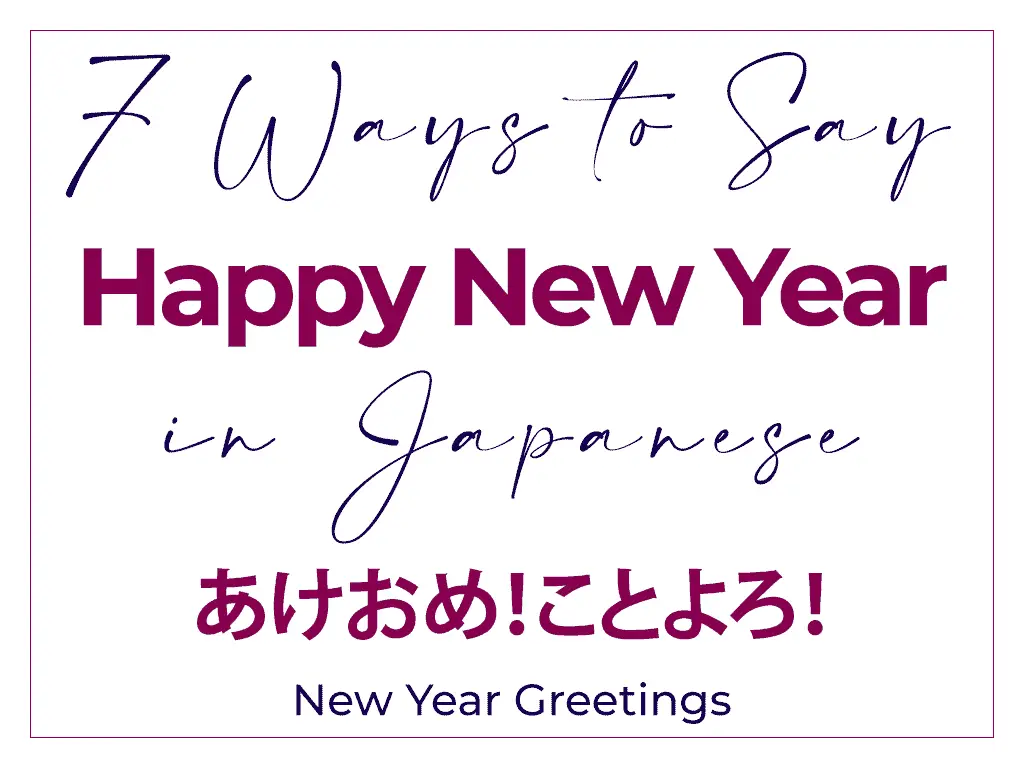In today’s lesson, I will tell you 7 different ways how to say “Happy New Year” in Japanese. In contrast to the English language, there is not only one new year greeting but a couple of phrases that are typically used to wish someone a happy new year. Which one you should use depends on the month and the person you are talking to.
In December, “Yoi otoshi o mukae kudasai” (良いお年を迎えください) or the casual “Yoi otoshi o” (良いお年を) are used to say “Happy New Year” in Japanese. From January on, “Akemashite omedetou gozaimasu” (明けましておめでとうございます) or the casual “Akemashite omedetou” (明けましておめでとう) are used to wish someone a happy new year.
But these are just 4 of the 7 important phrases that Japanese people use to say “Happy New Year“. Read on, if you want to know all the common new year greetings that are used before and after the new year including the most formal and the most casual ones.
How to Say “Happy New Year” in Japanese
- Akemashite omedetou gozaimasu – 明けましておめでとうございます
- Kotoshi mo yoroshiku onegai shimasu – 今年も宜しくお願いします
- Yoi otoshi o mukae kudasai – 良いお年を迎えください
- Akemashite omedetou – 明けましておめでとう
- Yoi otoshi o – 良いお年を
- Akeome – あけおめ
- Kotoyoro – ことよろ
1. Akemashite Omedetou Gozaimasu (After New Year)
Akemashite omedetou gozaimasu (明けましておめでとうございます) is the polite Japanese phrase to wish someone a “Happy New Year” at the start of the new year. The formal phrase can be used from January 1st as a new year greeting for superiors, seniors, coworkers, older people, acquaintances, and strangers.
However, please be aware that you cannot say akemashite omdeteou gozaimasu (明けましておめでとうございます) before January 1st. The phrase is only used once the new year has started. It is not used in December.
If you are curious about the exact meaning of the phrase “Akemashite Omedetou”, please check out my linked blog post. It explains in detail the deeper meaning behind the words akemasu (明けます) and omedetou gozaimasu (おめでとうございます).
Akemashite omedetou gozaimasu
明けましておめでとうございます
Happy New Year (from January 1st)
Sometimes you might also hear or see the phrase shinnen akemashite omedetou gozaimasu (新年明けましておめでとうございます). It is a slightly more traditional and less common way to wish someone a happy new year in spoken Japanese. However, you might see it written on one of the typical Japanese new year cards.
Shinnnen, akemashite omedetou gozaimasu
新年、明けましておめでとうございます
Happy New Year (from January 1st, traditional)
2. Akemashite Omedetou (After New Year – Casual)
Akemashite omedetou (明けましておめでとう or in hiragana only あけましておめでとう) is the more casual way to say “Happy New Year” in Japanese and is used once the new year has started. It is the common new year greeting in less formal situations and said to friends, close coworkers, and other people you know well.
Same as the polite version, akemashite omedetou (明けましておめでとう) is only used in January – once the new year has started. In contrast to the English phrase, it cannot be used to wish someone a happy new year in December.
Akemashite omedetou
明けましておめでとう
Happy New Year (from January 1st, casual)
3. Yoi Otoshi o Mukae Kudasai (Before New Year)
Yoi otoshi o mukae kudasai (良いお年を迎えください) is the formal Japanese phrase that is used to wish someone a “Happy New Year” in December before the start of the new year. You can use this polite phrase with your boss, your coworkers, and people you are not that close with until the end of December 31st.
While the phrase can be used throughout the whole latter half of December, it cannot be used any more once the new year has started. In other words, it cannot be used from January 1st onwards.
Yoi otoshi o mukae kudasai
良いお年をお迎えください
Happy New Year (up until December 31st)
4. Yoi Otoshi o (Before New Year – Casual)
Yoi otoshi o (良いお年を) is the more casual way to say “Happy New Year” in Japanese. This informal phrase is used at the end of the current year and before the actual start of the new year until December 31st to wish friends, close coworkers, and other people you know fairly well a happy new year.
Similar to its longer version and the more formal phrase, yoi otoshi o (良いお年を) is not used from January 1st onwards.
Yoi otoshi o
良いお年を
Happy New Year (up until December 31st, casual)
5. Akeome (Very Casual New Year Greeting Among Friends)
Akeome (あけおめ) is the abbreviation of akemashite omedetou (明けましておめでとう) and a very casual way to wish someone a happy new year in Japanese. It is usually used among (close) friends and young people and should only be said in casual settings. Sometimes it’s also written in kanji 明けおめ or katakana アケオメ.
Akeome
あけおめ
明けおめ
アケオメ
Happy New Year (from January 1st, very casual)
6. Kotoshi mo Yoroshiku Onegai Shimasu (New Year Greeting)
Kotoshi mo yoroshiku onegai shimasu (今年もよろしくお願いします) is a traditional new year greeting that is often said after wishing someone a happy new year with akemashite omedetou (明けましておめでとう) or akemashite omedetou gozaimasu (明けましておめでとうございます) and translates as “Please treat me well this year, too“.
This phrase is really difficult to translate and sounds extremely awkward in English. But it is an important phrase that conveys gratitude for the time you are going to spend together this year and expresses your hope to keep a good (and close) relationship with that person.
Kotoshi mo yoroshiku onegai shimasu
今年も宜しくお願いします
I look forward to your continued patronage again this year!
I look forward to working with you again this year!
Please treat me well this year, too!
7. Kotoyoro (New Year Greeting – Casual)
Kotoyoro (ことよろ) is the abbreviation of kotoshi mo yoroshiku onegai shimasu (今年もよろしくお願いします) and the more casual version of the typical new year greeting. It usually follows the casual way of saying “Happy New Year” in Japanese, which is akeome (あけおめ) and should only be used among friends.
Kotoyoro
ことよろ
I look forward to your continued patronage again this year! (casual)
I look forward to another great year with you! (casual)
Please treat me well this year, too! (casual)
Since the two phrases are typically used together I suggest you remember them as one phrase:
Akeome! Kotoyoro!
あけおめ!ことよろ!
Happy New Year (from January 1st, very casual)
How to Say “New Year” in Japanese (Kanji & Hiragana)
Oshougatsu (お正月) is the Japanese word for “new year” and especially refers to the first three days (sometimes five days) of the new year. In kanji, it is written as お正月 and in hiragana, it is written as おしょうがつ. It can also be translated as “New Year’s Day“, but doesn’t only refer to January 1st.
oshougatsu
お正月
new year



Hi Alex. thanks for your lessons. Can we use あけましておめでとうございます in the first 5 days of the new year or not?
Hey Sajede (⌒‐⌒)۶
Yes, you can use あけましておめでとうございます in the first couple of days of the new year.
Cheers,
Alex
Thank you very much.